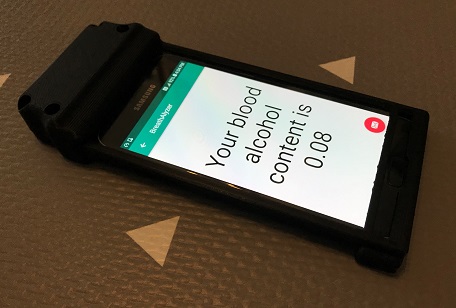Researchers at Laval University are developing an optical breathalyzer that can be integrated into the screen of a mobile device. This technology could provide an accessible, inexpensive way to check blood alcohol content (BAC) and reduce alcohol-related accidents and deaths.
The technology works by measuring the evaporation rate of the fog that is produced when the user breathes on the phone screen. Since alcohol evaporates faster than water, the higher the alcohol content in the breath, the quicker the evaporation rate.
The researchers used components that are already built into smartphones to create the optical breathalyzer. The phone’s display serves as the light source, and the dense stress layer of glass over the screen works as a planar waveguide. The researchers added only one component — a photodiode — which is used to measure the optical signature of the light from the display.
With the device, the group successfully demonstrated a correlation between the light intensity signature and the user’s BAC.

A research group at Laval University has created a prototype of an optical breathalyzer that is embedded in a smartphone. The user breathes on the screen, and the device measures blood alcohol content based on the evaporation rate of microdroplets from the user’s breath. Courtesy of Jerome Lapointe/Laval University.
Under normal conditions, light from the phone’s display will pass through the glass stress layer without being deflected. However, when the screen is fogged, some of the light will become coupled to the planar waveguide due to a strong total internal reflection that occurs at the edge of each microdroplet.
The coupled light is guided to one side of the screen, where its intensity is measured by the photodiode. The light intensity measured by the photodiode is proportional to the number of microdroplets on the screen. When the fog contains alcohol, the microdroplets on the screen evaporate at a faster rate, and the intensity measured by the photodiode decreases at a faster rate.
The researchers’ prototype was powered by a phone battery and an app to guide the user on how to take the blood alcohol test. They first tested the prototype on a volunteer in a laboratory. Then, to identify any parameters that might affect the measurements, they tested the prototype in real-world environments, taking 140 measurements from 36 volunteers over the course of three gatherings where alcohol was served.
Analysis of the 140 evaporation curves over time allowed the team to identify several parameters and conditions affecting the measurements, as well as ways to improve the accuracy of the device.
“While the technology works well in a controlled environment, the ambient conditions in a real-world environment greatly affect the measurements,” research scientist Jerome Lapointe said. “For example, if it is warmer or less humid, the fog on the screen evaporates at a faster rate.
“It will be necessary to test in all possible conditions so that the breathalyzer can be calibrated,” he said. “Fortunately, today’s phones have several sensors, including temperature and humidity ones, that can be used to record all conditions for each test.”
The researchers plan to use the prototype to acquire a large data set of BAC optical signatures, to train a deep neural network and use machine learning to obtain accurate BAC measurements. Using this approach, the researchers hope to develop an ecological, inexpensive, and discreet breathalyzer for smartphones and smartwatches.
“After accumulating a large database, we hope to use artificial intelligence by training a neural network to obtain accuracy that will convince major phone manufacturers to integrate the breathalyzer into screens,” Lapointe said.
The research was published in Sensors (www.doi.org/10.3390/s21124076).